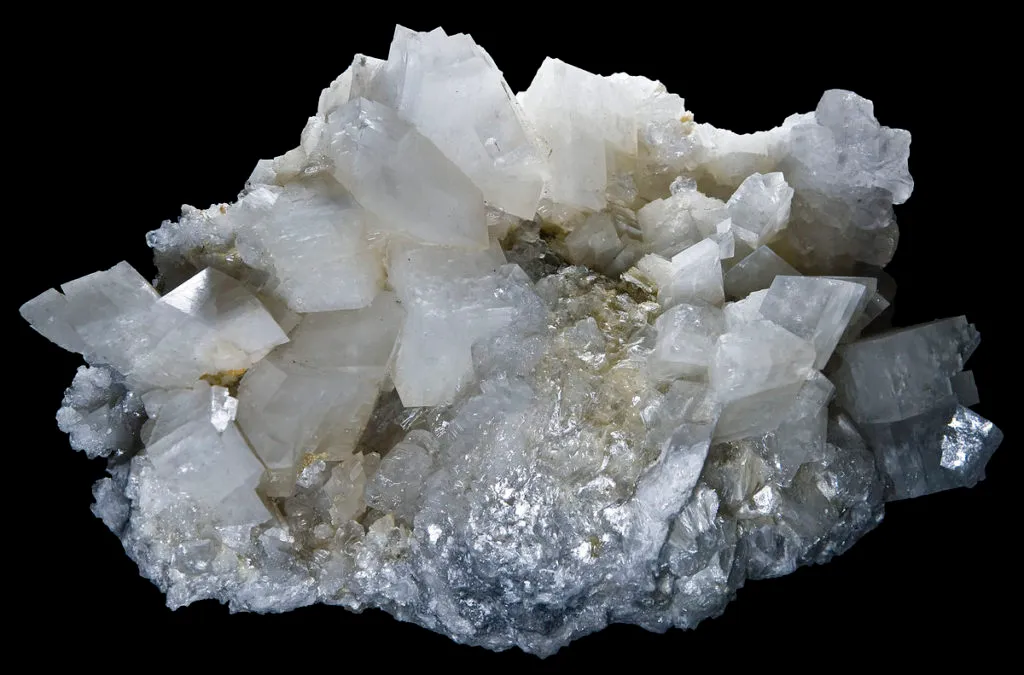
Appearance
Dolomite can be found in a variety of hues, such as pink, green, brown, white, and gray. The presence of contaminants and trace elements in the mineral determines its particular color. These impurities frequently induce differences in the crystal lattice of the mineral, which results in different colors. On its cleavage surfaces, dolomite usually has a vitreous (glassy) to pearly luster. The way light interacts with the flat surfaces of the material gives it a distinctive sheen, which is responsible for its luster. Rhombohedral crystals are formed when dolomite crystallizes in the trigonal crystal system. Dolomite’s unique crystal symmetry and forms are a result of this crystal system.
Geographical Distribution
Dolomite is found in many different habitats and geological settings throughout the world. Rocks containing dolomites are found in several notable locations, including the Dolomites, Italy, the Midwest of the United States, Spain, China, and South Africa.
History
According to Nicolas-Théodore de Saussure, Carl Linnaeus most likely published the first description of the mineral dolomite in 1768. The French naturalist and geologist Déodat Gratet de Dolomieu first identified it as a rock in 1791, describing it as found in structures in the old city of Rome and then in samples he had taken in the Tyrolean Alps. In March 1792, Nicolas-Théodore de Saussure gave the mineral its original name (after Dolomieu).
Chemical Composition
Dolomite, having the chemical formula CaMg(CO3)2, is a calcium magnesium carbonate mineral. Because it contains both magnesium carbonate (MgCO3) and calcium carbonate (CaCO3), its composition determines its chemical characteristics.
Dolomite’s composition, which consists of one calcium atom (Ca), one magnesium atom (Mg), and two carbonate ions (CO3) in the crystalline structure, is reflected in its chemical formula. The specific characteristics of dolomite are derived from the configuration of these atoms.

Uses
Because of its unique chemical and physical characteristics, dolomite is used in many different industries. The following are some of the main uses and importance of dolomite:
- Construction and Building Materials: Dolomite is frequently utilized as a building and construction material. Road bases, driveway bases, and footpath bases are frequently constructed from crushed dolomite. In addition to preventing erosion and settling, it offers a solid base. In order to increase the strength and longevity of concrete and asphalt, dolomite aggregates are also utilized in their production.
- Magnesium Production: One important source of magnesium, which is needed for many different purposes, is dolomite. It is used as a raw material to make alloys and magnesium metal. Magnesium oxide (MgO), which is extracted from dolomite by heating it to high temperatures, can be utilized in a variety of industrial operations.
- Agricultural Applications: In agriculture, dolomite is applied as a soil conditioner to help acidic soils achieve a better pH equilibrium. It has magnesium and calcium, both of which are good for plant growth. Dolomite has the ability to improve overall soil fertility, increase nutrient absorption, and neutralize soil acidity.
- Fertilizer Additive: Dolomite is occasionally used as a source of magnesium and calcium. The health and growth of plants depend on these minerals. Fertilizers with a dolomite basis work especially well for crops like tomatoes and peppers that need greater magnesium concentrations.
- Refractory: Dolomite is an excellent substance to utilize in refractory materials because of its high melting point and resilience to heat and fire. In industrial furnaces, kilns, and other high-temperature settings where heat resistance is essential, these materials are employed.
- Glass and Ceramics Production: Dolomite is utilized as a calcium and magnesium source in the creation of glass and ceramics. It can strengthen the durability of glass products and enhance the qualities of ceramic glazes.
- Water Treatment: Dolomite is occasionally utilized in wastewater and drinking water treatment procedures to aid in the removal of contaminants. It can supply alkalinity to balance acidic water and help remove heavy metals.
- Metal Smelting: When smelting metal, dolomite can be employed as a fluxing agent. By lowering the melting point of the materials being treated, it can help to increase the extraction efficiency of metals.
- Dimension Stone: In landscape and architecture, specific dolomite variants with eye-catching colors and patterns are employed as ornamental and decorative stones. These polished stones are frequently used for flooring, countertops, and other outdoor and interior design components.
Table





